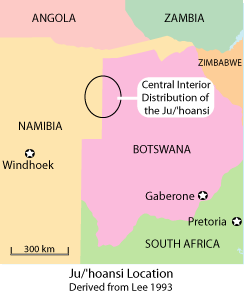Anthropologist Richard B. Lee, adding a new dimension to his research on the Ju/’hoansi, has recently emphasized the importance of their experience for understanding the rapid spread of AIDS. Lee explained his current research on the AIDS epidemic in Africa, and particularly in the Ju/’hoansi society of Northern Botswana and adjoining Namibia, at a lecture on the University of Alberta campus recently.

According to an article in the Edmonton Journal on March 11, 2005, Lee believes that young people in Namibia and in Canada (he is a professor at the University of Toronto) engage in roughly the same amount of sexual activity. However, with one out of five Namibians already testing HIV positive or infected with AIDS, he finds that the young people there have a fatalistic attitude toward the danger of contracting the disease. In many cases they exchange cell phones, cars, or cash for sex, which is often unprotected. Astonishingly, 60 percent of the young Namibians assume they will contract the disease within the next year.
Not so the Ju/’hoansi, a minority society in Namibia as well as in Botswana, that has a 75 to 90 percent lower rate of infection than the rest of the population. Lee’s analysis: “The key thing about the Ju/’hoansi is their high status of women.” He explains that in the hunting and gathering lifestyle that used to prevail in their society, women produced 70 percent of the food. They had a lot of status and self-confidence because of the traditional value of their food gathering.
Young Ju/’hoansi women still maintain that tradition of self respect: a woman may make her own plans for her marriage in their society, and she can refuse the advances of a man if he isn’t using a condom. Lee, who has studied the Ju/’hoansi since 1963, does not find that same level of self confidence among non-Ju/’hoansi women. He neatly sums up the difference between them and the Ju/’hoansi: “It’s really a question of women’s empowerment.” If unprotected sex “is a form of violence against women,” as Lee suggests, then Ju/’hoansi women frequently avoid such violence because of their long traditions of strength, independence, and self-assurance, all of which are essential aspects of their society.
Two different articles by Lee and his co-investigator, Ida Susser, on AIDS, the Ju/’hoansi, and women’s empowerment have appeared in scholarly publications which are available on the Web. One by both Lee and Susser in the first issue of Culture Matters, in 2002, provides much more nuanced explanations of this situation than the article in the Edmonton Journal did. Another article by Susser in Anthropologica, in 2003, gives additional information and analysis.